Development and design
During World War II there was considerable infighting between the Imperial Japanese Army and the Imperial Japanese Navy as both competed for scarce resources. A consequence of this competition is that each produced similar but different weapons. An example of this competition was the Army Type 4 20 cm rocket launcher and the 20 cm naval rocket launcher. [3]
The 20 cm naval rocket launcher was developed in the final stages of World War II by the Japanese Navy, as a low-cost, easy to produce weapon for use by naval troops as a last-ditch weapon for the defense of Japanese occupied islands. The first units were used successfully during the Battle of Peleliu in 1944. [3]
The 20 cm naval rocket was a modification of a standard 203 mm (8 in) naval projectile by screwing a rocket booster to the projectile. The rocket was ignited by a percussion cap which screwed into the base of the projectile and the rocket consisted of 7 sticks of double base solid-propellant whose exhaust gasses were forced through six venturis drilled in the base of the rocket at a 25° angle which rotated the projectile in a clockwise direction imparting spin-stabilization. Type 91 trinitroanisole explosive was poured into a lacquered shell body intended to stop the formation of picrate salts and the projectile was centrifugally armed by a nose fuze. [1]
Launchers
The rocket could be launched from a sheet metal or wooden launch trough with a bi-pod, placed against an earthen embankment, or from a pipe or culvert. They were usually employed in groups of two or three covering landing beaches and although cheap and portable traverse and elevation were slow and the projectile range was short. [3]
A mobile rocket launcher was first found on Iwo Jima. It has a barrel about 6 ft (1.8 m) long and was mounted on a steel split trail carriage with two spades. There were two wooden spoked wheels with hard rubber tires for easy transport. Elevation and depression were by an elevating handle located at the left of the barrel just forward of the trunnions. When the desired angle was reached, the clamping handle at the left is rotated to lock the tube in position. The maximum elevation was 73° with no carriage traverse. A percussion type firing mechanism located on top of the breech is fired by an attached lanyard. [4]

The Type 96 25 mm gun was an automatic cannon used by the Imperial Japanese Navy during World War II. A locally-built variant of the French Hotchkiss 25 mm anti-aircraft gun, it was designed as a dual-purpose weapon for use against armored vehicles and aircraft, but was primarily used as an anti-aircraft gun in fixed mounts with one to three guns.
This article explains terms used for the British Armed Forces' ordnance (weapons) and ammunition. The terms may have different meanings depending on its usage in another country's military.

The Type 97 81 mm infantry mortar was a Japanese mortar used primary by Imperial Japanese Army during World War II. The Type 97 designation was given to this gun as it was accepted in the year 2597 of the Japanese calendar (1937). It entered service in 1937. Japanese infantry units often are equipped with 81-mm mortars. The Type 97 81 mm mortar is very commonly used and is referred to by the Japanese as an "Infantry Gun", which breaks down into 3 sections for transport. The markings which appear on the base of the barrel read "97 model small trench mortar."
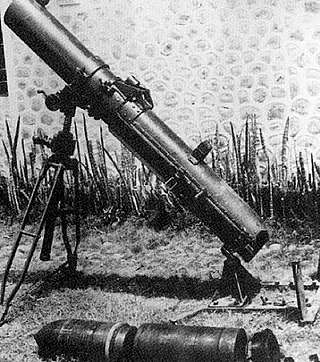
The Type 4 20 cm rocket mortar was a 203 mm rocket mortar used by the Imperial Japanese Army in the final stages of World War II.

Gun laying is the process of aiming an artillery piece or turret, such as a gun, howitzer, or mortar, on land, at sea, or in air, against surface or aerial targets. It may be laying for either direct fire, where the gun is aimed directly at a target within the line-of-sight of the user, or by indirect fire, where the gun is not aimed directly at a target within the line-of-sight of the user. Indirect fire is determined from the information or data that is collected, calculated, and applied to physical coordinates to identify the location of the target by the user. The term includes automated aiming using, for example, radar-derived target data and computer-controlled guns.

Rocket artillery is artillery that uses rockets as the projectile. The use of rocket artillery dates back to medieval China where devices such as fire arrows were used. Fire arrows were also used in multiple launch systems and transported via carts. The first true rocket artillery was developed in South Asia by the Tipu Sultan, the ruler of the Kingdom of Mysore. In the late nineteenth century, due to improvements in the power and range of conventional artillery, the use of early military rockets declined; they were finally used on a small scale by both sides during the American Civil War. Modern rocket artillery was first employed during World War II, in the form of the German Nebelwerfer family of rocket ordnance designs, Soviet Katyusha-series and numerous other systems employed on a smaller scale by the Western allies and Japan. In modern use, the rockets are often guided by an internal guiding system or GPS in order to maintain accuracy.
A gun carriage is a frame or a mount that supports the gun barrel of an artillery piece, allowing it to be maneuvered and fired. These platforms often had wheels so that the artillery pieces could be moved more easily. Gun carriages are also used on ships to facilitate the movement and aiming of large cannons and guns. These are also used in the funeral procession of any higher authority of any state and country.
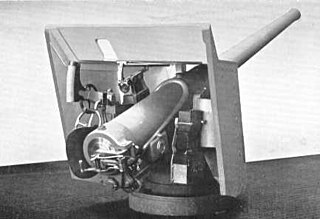
The QF 4.7-inch Gun Mks I, II, III, and IV were a family of British quick-firing 4.724-inch (120 mm) naval and coast defence guns of the late 1880s and 1890s that served with the navies of various countries. They were also mounted on various wheeled carriages to provide the British Army with a long range gun. They all had a barrel of 40 calibres length.
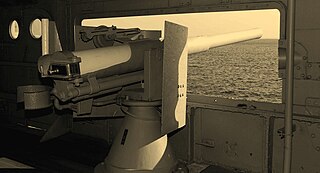
The QF 12-pounder 12-cwt gun (Quick-Firing) was a common, versatile 3-inch (76.2 mm) calibre naval gun introduced in 1894 and used until the middle of the 20th century. It was produced by Armstrong Whitworth, Elswick and used on Royal Navy warships, exported to allied countries, and used for land service. In British service "12-pounder" was the rounded value of the projectile weight, and "12 cwt (hundredweight)" was the weight of the barrel and breech, to differentiate it from other "12-pounder" guns.

The 68-pounder cannon was an artillery piece designed and used by the British Armed Forces in the mid-19th century. The cannon was a smoothbore muzzle-loading gun manufactured in several weights, the most common being 95 long cwt (4,800 kg), and fired projectiles of 68 lb (31 kg). Colonel William Dundas designed the 112 cwt version in 1841 and it was cast the following year. The most common variant, weighing 95 cwt, dates from 1846. It entered service with the Royal Artillery and the Royal Navy and saw active service with both arms during the Crimean War. Over 2,000 were made and it gained a reputation as the finest smoothbore cannon ever made.

The Type 38 12 cm howitzer (1905) is an obsolete Japanese field piece used by the Imperial Japanese Army during World War I, Second Sino-Japanese War, and World War II. The Type 38 designation was given to this gun as it was accepted in the 38th year of Emperor Meiji's reign (1905). It was encountered by Allied forces for the first time on Iwo Jima, and it may have been used as an emergency or substitute weapon.

The EOC 10 inch 40 caliber guns were a family of related guns designed by the Elswick Ordnance Company and produced by Armstrong Whitworth in the 1890s for export customers. EOC 10 inch 40 caliber guns were the primary armament of armored cruisers, ironclads and pre-dreadnought battleships built or refit during the 1890s. These guns and their licensed derivatives armed ships of the Argentine Navy, Imperial Japanese Navy, Regia Marina and Spanish Navy. They served in the Russo-Japanese War, Italo-Turkish War and World War I.

The EOC 8 inch 45 caliber were a family of related 8-inch (203 mm) 45 caliber naval guns designed by the Elswick Ordnance Company and manufactured by Armstrong for export customers before World War I. In addition to being produced in the United Kingdom licensed variants were produced in Italy and in Japan. Users of this family of gun included the navies of Argentina, Chile, China, Italy, Japan and Spain. This family of guns saw action in the Spanish–American War, Boxer Rebellion, Russo-Japanese War, Italo-Turkish War, World War I and World War II. In addition to its naval role it was later used as coastal artillery and siege artillery after the ships it served on were decommissioned.

The Canon de 19 C modèle 1875 was a coastal defense gun designed and built in the 1870s. A number of guns were also converted to railway guns during World War I in order to meet a need for heavy artillery.

The Type 10 and Type 3 rocket boosters were rocket artillery systems used by garrison troops of the Imperial Japanese Navy during the late stages of World War II in defense of island bases in the Pacific.

The Type 7 30 cm howitzer was a howitzer used by the Imperial Japanese Army in the Second Sino-Japanese War, Soviet–Japanese border conflicts and during the Pacific Campaign in World War II. The designation Type 7 indicates its year of introduction, the seventh year of the reign of Emperor Taishō, or 1918 according to the Gregorian calendar.
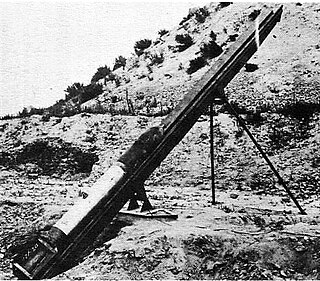
The Type 21 and Type 22 rocket-bombs were rocket artillery systems used by garrison troops of the Imperial Japanese Navy during the late stages of World War II in defense of island bases in the Pacific.

The 20 cm/12 short naval gun was a naval gun used by the Imperial Japanese Navy to defend merchant ships and land bases during World War II.

The Type 45 15 cm cannon (四五式十五糎加農砲) was a coastal defense gun and heavy artillery used by the Imperial Japanese Army during the World War II. The designation Type 45 indicates the year of its introduction, the 45th year of the Meiji period or 1912 according to the Gregorian calendar.
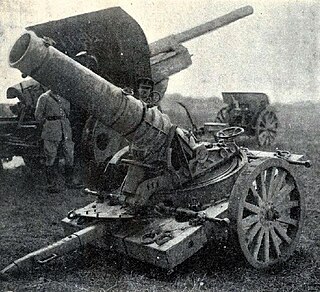
The 24 cm schwere FlügelMinenWerfer Albrecht, or 24 cm sFIMW 17 Albrecht, was a heavy mortar used by the Imperial German Army during the First World War.





















